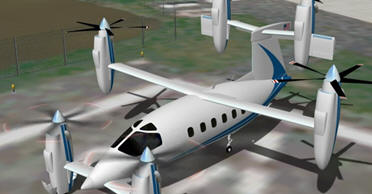|
|||||||||||||||||
|
|
|
|||
|
Oliver VTOL To Build
Commercial Version Of The "Hexplane" By Mike Mitchell |
||||
 |
January 17, 2012 - Oliver VTOL announced a commercial
concept of its "Hexplane," an innovative six-engine
vertical take-off and landing (VTOL) aircraft that holds
the promise to fly faster, further and safer than any
VTOL in the industry. The commercial Hexplane concept, based on a Boeing 737-100 fuselage, has three wings and propulsion units from Bell/Boeing?s V-22 Osprey. The commercial Hexplane could fly above 30,000 feet at cruise speeds greater than 425 miles per hour with ranges exceeding 1,500 miles. A Boeing 737-100 has a ceiling of 35,000 feet at cruise speeds of 485 miles per hour with a maximum range of 1,770 miles. |
|||
|
Like other
versions of the Hexplane, the commercial version Hexplane will
also be able to continue to perform full gross weight vertical
operations if a propeller, engine or a gearbox fails - the first
VTOL with these capabilities.
"The
commercial version of the Hexplane is a powerful proof of
concept that we have overcome the historic challenges for VTOLs,
achieving the speed, range and payload to similarly powered
fixed wing aircraft,? said Richard Oliver, founder and chief
executive officer (CEO) of Oliver VTOL and the designer of the
aircraft. ?However, the Hexplane goes further by providing the
ability to perform a safe maximum gross weight vertical landing
at its hover out of ground effect (HOGE) limit altitude with a
failed propeller, gearbox or engine."
The
commercial Hexplane also holds great potential to help relieve
congestion at major airport hubs which is creating increased
pressure on airspace and runway capacities, according to several
aviation industry experts.
?As the
country?s scheduled air carrier industry continues on a
decade-long contraction in markets serviced, coupled with a
transition to larger fixed-wing aircraft, flying on longer legs,
numerous third- and even many second-tier markets are being
vacated,? said Dr. Bruce J. Holmes, CEO of NextGen AeroSciences,
LLC. ?This trend is neither good for the communities affected
nor the nation's economic performance. |
||||
|
?Meanwhile, the
demand for air access to communities continues to grow, creating
increasing pressures on a decreasing number of airports, and leading to
growing delays and reducing the speed by which we can conduct our
commerce and enjoy our leisure. Concepts such as Hexplane hold potential
for relief from this long-term downward trend in the nation's aviation
connectivity, and represent a ?disruptive technology? of the sort that
leads to new services of value to the flying public.?.
The U.S. Patent
office published Richard Oliver?s patent application for the Hexplane on
July 14, 2011. The company expects to receive a patent for the aircraft
in the next 12 to 18 months. The Hexplane's capabilities have been
validated in a report issued by DAR Corporation, Lawrence, Kan. The
scientific advisors for the report were: Dr. Willem Anemaat, president
of DAR Corporation; University Of Kansas Professor Emeritus Dr. Jan
Roskam, founder of DAR; and Penn State Boeing Professor Emeritus, Dr.
Barnes W. McCormick.
In October 2011,
Oliver VTOL LLC announced a ?Hexplane Heavy Lift (HHL)? concept that has
the potential to meet the military?s need for a new, large vertical
take-off and landing (VTOL) transport aircraft.
The Oliver VTOL
HHL concept could be a strong contender to meet the requirements of the
military?s Joint Vertical Aircraft Task Force (JVATF). The Joint Future
Theater Lift (JFTL), Army Heavy Lift (AHL) and the Heavy Lift
Replacement (HLR) requirements have continually changed since the Quad
Tilt Rotor (QTR) was proposed in 1999, mainly due to the growth in the
military?s planned Future Combat System (FCS) payloads.
Oliver VTOL?s
Hexplane HHL concept was filed in a U. S. Patent office application on
September 12, 2011. The aircraft has three wings and six rotating
propulsion units with a payload capability similar to the cargo capacity
of a Lockheed C-130J-30.
Based on early
analyses and flight simulations, the Hexplane HHL would fly above 25,000
feet at cruise speeds greater than 425 mph with ranges exceeding 1,500
miles. The Hexplane HHL landing requirements are significantly smaller
than current QTR concepts, a key factor in the ability of a heavy lift
VTOL to operate from naval ships and confined landing zones.
The Hexplane is
designed using well understood applied aerodynamic engineering
principals and therefore does not require expensive advanced development
activities which usually plague novel VTOL solutions. Advanced
development costs must be amortized over the typically small quantity of
aircraft produced adding significantly to their cost.
A planned Hexplane
technology demonstrator is expected to have a ceiling greater than
35,000 feet and carry a load of 1,000 pounds, 1,000 statute miles at 400
miles per hour. This is a capability that the Defense Advanced Research
Projects Agency (DARPA) has challenged the aviation industry to
accomplish. Oliver VTOL officials believe the Hexplane technology could be used in both manned and unmanned flight operations for the military. The aircraft also could be used as an air ambulance because its speed and range would allow the transport of patients faster and further to access more trauma centers than currently possible. Other applications include offshore oil platform support, search and rescue, and business aviation. |
|
|
| blog comments powered by Disqus |
 |
| ?AvStop
Online Magazine
Contact
Us
Return To News
|
|

